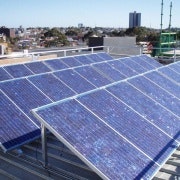A winter solstice for Queensland solar
Referring to the Draft Energy White Paper that had already DEWP'd solar, the Queensland energy minister made a decision to “continue the solar bonus scheme”, but slashed the rate from 44 cents to 8 cents per kilowatt-hour (kWh).
Some 'continuation'!
But while some may scream about this, it's not all bad news. However, there are considerable implications for the PV industry outside of Queensland.
The good news for solar householders is that applications remain open until July 9. Applicants will have 12 months to connect to the grid following this date. Thankfully the action is not retrospective (it seems like the Queensland government doesn't wish to repeat the mistakes of their southern neighbour).
The other (mildly) good news is that it appears that electricity consumers with companies such as AGL, Origin, and TRU energy will be able to receive an additional 6 to 8 cents per kWh on top of the 8 cents offered by the government. Following the end of two years worth of government payments (not much incentive if you wish to buy in late 2013), the additional payment will be reviewed. This leaves open the possibility that it could be removed, leaving only voluntary retailer contribution.
Danger: Precedent
The danger is that this continues to send the message that solar power is worth less than electricity sourced from a distant coal-fired generator.
It could also influence the Victorian government's review of its own feed-in tariff (FiT). The 8 cents per kWh is half the rate offered by the South Australian government, which also mandates a minimum additional retailer contribution that grows over time. The Victorian transitional FiT is only months away from reaching its 75 megawatt cap. And the Victorian Competition and Efficiency Commission draft recommendation has not been finalised, but recommends no replacement of the transitional FiT the government currently has in place. It also suggests an adjustment to the definition of a 'fair and reasonable' rate retailers should pay.
The Queensland government seems to be singing from the same hymn book in asking the Queensland Competition Authority to recommend a ‘fair and reasonable' solar feed-in tariff. People familiar with developments in NSW will remember that the NSW government's ‘fair and reasonable' definition seemed only fair and reasonable to the coal generators they owned and were trying to sell... Little wonder state governments wish to send the message that solar is worth less than coal.
The only excuse they fall back on for not giving solar power the same value as retail electricity is the structure of the National Electricity Rules (which were written by the states long before solar power became popular). In spite of calls for urgent reform and broad recognition that the current rules penalised solar power and rewarded network gold-plating; governments have not even made glacial progress on reform in the past five years.
The unpopular result has been high electricity prices driven by the cost of network infrastructure to service people's desire for air conditioning. Ironically, it's the state governments that receive a guaranteed dividend from the electricity distributors investments that represent 50 per cent of electricity bills, even while they try to blame solar for rising power prices.
Better than a knee jerk
In spite of the Queensland government's sizable adjustment to the feed-in tariff, SunWiz believes that the government has acted in a fair and reasonable way by providing Queenslanders considering solar power the opportunity to drastically reduce their electricity bills. Though there will still be good reason to buy solar after July 9 2012, Queenslanders should make the most of the present opportunity. For those who can't draw together the funds required to buy a solar system before the application deadline, most solar companies are now offering finance.
The government has also been fair to the solar industry by providing notice of the change. The local solar industry will have to manage three weeks of high call volumes, but 12 months should be plenty of time to install the systems. This will allow for high quality installation practices to continue and provide time for solar retailers to transition through a quieter post-44c per kWh aftermath into a more stable future. This is a far better outcome than a government knee-jerk reaction to a runaway train that could have shut down businesses overnight, as has happened in states such as NSW.
National Implications
Today's announcement has national implications. Solar wholesalers should consider gearing-up operations to meet an expected period of higher demand. Given the continued high demand in Germany, this may increase pressure on supplies of high-quality product – affecting its availability and price. Thankfully the installation rush will not be coincide with the rush to install before the solar multiplier reduces on June 30, but will coincide with pressures on call centres and field operations.
Another factor to consider is that the small scale renewable energy certificate (STC) price is likely to fall on this announcement due to the extra volume of certificates available on the market. Those Queensland PV retailers selling systems now should be wary of such price volatility when they come to install.
The good news is that the solar industry in Queensland will still survive, albeit at lower levels. The chart below illustrates that Queenland was by far and away the most important solar PV market in Australia for 2012.

Modelling in which SunWiz was involved suggests a set-back to pre-2011 sales, and only about 40 per cent the size of 2012's expected volume.
In spite of this drop, Queensland could still retain its crown as the Sunshine State. However, depending on how unfairly and unreasonably the Queensland government wishes to treat its sun-loving citizens, this winter solstice may be remembered as the start of a long midwinters night for Queensland.
Warwick Johnston is Managing Director of Sunwiz Consulting
This article was originally produced by Sunwiz, republished with permission.
















